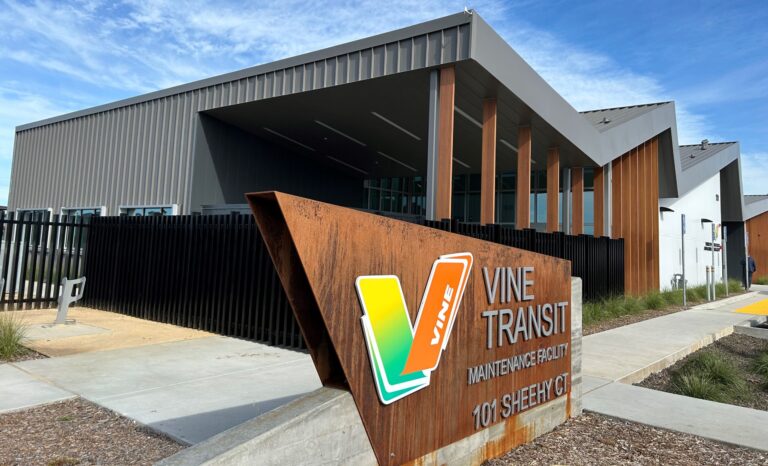Kimley-Horn provided design services for the Vine Transit Maintenance Facility in Napa Valley, paving the way for...
Clear Communication
Created a guide for Caltrain to increase communication and information-sharing between jurisdictions, cities, and other transit partners working to address at-grade rail crossings
Stakeholder Engagement
Conducted outreach with all 21 jurisdictional staff and elected officials as well as staff from the local transportation agencies to inform the content for the Caltrain Corridor Crossings Delivery Guide
Strategic Planning
Developed short- and long-term plans for the Caltrain corridor, laying the groundwork for increased service, ridership, and train frequency to be implemented in the future
Prior to the COVID-19 pandemic, Caltrain assessed its future operations, service, and prospective ridership as well as their long-term vision of service through 2040. The owner and operator of the rail corridor stretching from San Francisco to Gilroy concluded that addressing at-grade railroad crossings—specific areas where safety issues such as vehicular and pedestrian conflicts with trains can occur due to crossings—was essential.
Many corridor cities want to implement at-grade separations or enhance their safety to improve their jurisdiction’s regional connectivity and multimodal transportation access, yet there has been no cohesive corridor approach to balancing the corridor’s grade crossing ambitions with available resources. Kimley-Horn, which held the planning on-call contract for Caltrain at the time, was selected as the consultant to develop a programmatic approach to grade crossing projects along the Caltrain corridor.
Providing Caltrain with Comprehensive Services
To promote information-sharing and provide a resource for jurisdictions, cities, and other partners along the Caltrain corridor, Kimley-Horn created the Caltrain Corridor Crossings Delivery Guide. This resource defines the processes, procedures, roles, responsibilities, and other considerations needed to deliver grade separation or closure projects. For the delivery guide project and long-term corridor strategy, we provided the following services:
- Program management
- Stakeholder engagement and outreach
- Rail design engineering
- Funding
- Strategic planning
We began with a discovery phase to explore the current issues surrounding at-grade railroad crossings and the experiences of different jurisdictions along the Caltrain corridor. This was done by conducting interviews with both the jurisdictions and with various departments within Caltrain. Since grade separation projects are often large and costly, coordination can be challenging and funding is frequently allocated on a first-come, first-served basis. With this information, our team continued coordinating with additional stakeholders to begin developing the delivery guide to address these issues, aiming to enhance communication, transparency, and consistency along the corridor.
Stakeholder-Driven Approach
Several key stakeholders organized and brought the delivery guide to life—including Caltrain, the Santa Clara Valley Transportation Authority (SCVTA), the San Francisco County Transportation Authority (SFCTA), the San Mateo County Transportation Authority (SMCTA), and select staff from the 21 jurisdictions along the corridor. To begin crafting the guide, our team met monthly with staff and elected officials from every jurisdiction for more than a year, discussing the crossings removal process, associated design and construction procedures, and other key topics that helped inform the delivery guide and goal setting for the corridor’s future. After pinpointing areas for further discussion, our team held six design workshops with Caltrain engineers to review rail crossing removal standards, processes, and responsibilities and determine how to improve communication with the corridor cities and jurisdictions.
To make the delivery guide succinct and accessible to a variety of readers throughout the crossings removal process, we structured it to span project identification through completion. We further conducted three in-person, interactive workshops with Caltrain to align on the coordinated approach for the guide and envision the future program for the corridor. With these workshops and feedback from SCVTA, SFCTA, SMCTA, and other key stakeholders in the corridor, we received more than 500 comments to address. Once our team implemented the culminated feedback, the final Caltrain Corridor Crossings Delivery Guide was published on Caltrain’s website at the end of August 2024.
Looking to the Future of the Caltrain Corridor

Through our collaboration with Caltrain’s staff and our technical advisory services to create the delivery guide, Kimley-Horn has truly become an extension of Caltrain’s staff.
We also prepared strategy documentation for the Corridor Crossing Investment Program, a visionary program shift that outlines incremental steps to achieve the goals of increased service, ridership, and train frequency on the Caltrain corridor. This program prioritizes projects into implementation tiers with supporting activities and a funding strategy to deliver these projects. In the interim, as program manager of the grade crossings, we are beginning to implement some of this program strategy’s recommended practices with an integrated delivery team and a list of prioritized initiatives.
Jurisdictions and cities along the corridor will now be better equipped to manage at-grade crossings throughout their lifecycles with the delivery guide, further addressing circulation challenges, facilitating rail operations, and enhancing corridor safety.



